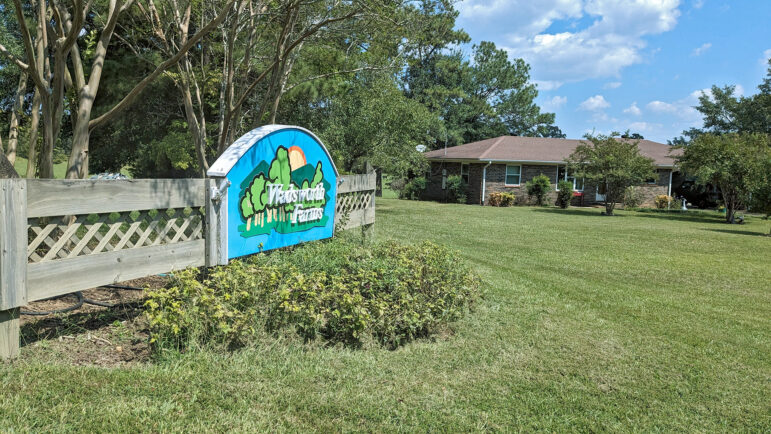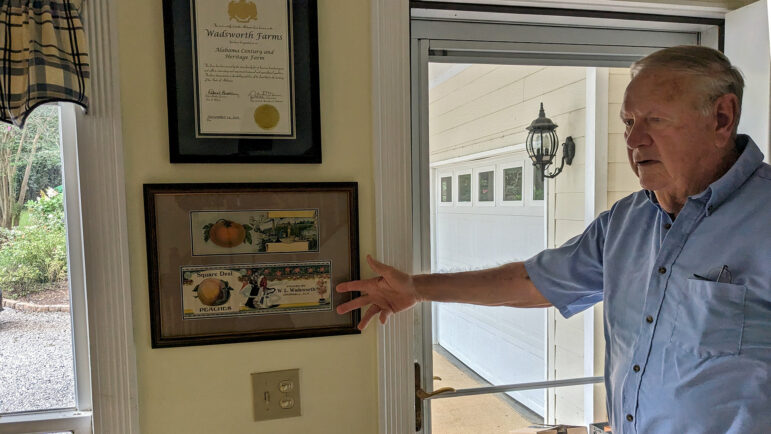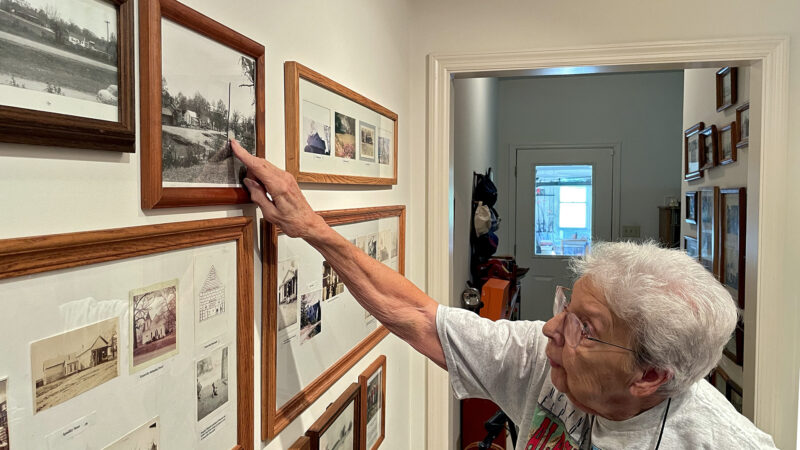Place, Erased: How a drowned Alabama town still holds lessons 60 years later
Jo Ann Winnette shows historical photos of Easonville, Alabama, that she keeps inside her home on Monday, Sept. 18, 2023, in Pell City, Alabama. Winnette lives on the part of her family’s land that isn’t underwater thanks to the creation of an Alabama Power dam in the area in the 1960s.
This story is part of a series from the Gulf States Newsroom called Place, Erased. Reporters traveled to communities in Mississippi, Alabama, and Louisiana that have been transformed by major environmental shifts. You can read other entries in the series here:
- Place, Erased: The fight for the remains of a Louisiana town
- Place, Erased: Is this Mississippi community really a ghost town? It depends on who you ask
About an hour east of Birmingham, Mike Wadsworth’s house sits on a road that drops off into a lake. It’s one of the few remains of Easonville, Alabama.
Wadsworth’s family were farmers who settled in Easonville in the mid-1800s. In his youth, he remembers Easonville as a small, rural town — a “wide spot in the road,” as he called it — but it was thriving. It had about three stores, and just as many churches.
“Everybody was friendly, at least to me,” Wadsworth said. “I’m sure there was some strife, but overall, I think it was a very pleasant place to live.”

Wadsworth spent his childhood having free range of the town, exploring the fields, the hills and valleys alongside his brother. His father was a lifelong member of the Easonville Methodist Church, and behind it was a cemetery.
“I always liked going through the cemetery because I see these family names,” he said. “And I knew I didn’t know who they were, but I knew they were relatives and it was just comforting.”.
Then, in the 1950s, residents began hearing of a proposal that would change their town forever: Alabama Power was building a hydroelectric dam.
The creation of the dam would drown Easonville slowly, and eventually wipe it off of the map. Today, all that remains is relocated buildings, graves and a few residents, like Wadsworth, who help keep its memory alive.
But 60 years after the Easonville project was completed, history looked to repeat itself as residents living near a neighboring Alabama mountain faced the same threat.
In both cases, the project was touted as a renewable power source. But both cases also showed that, sometimes, progress can come at a human cost.
The end of Easonville

In the 1960s, Alabama Power, the state’s main utility, began building the Logan Martin Dam, which would produce hydroelectric power. It was supposed to be a sign of progress. The area was getting a green energy source that would also increase the financial value of its surrounding communities and double as a recreation spot.
But there was a downside. To make the project a reality, Alabama Power began buying up property for the dam that would eventually create Logan Martin Lake, and Easonville residents had to leave.
Wadsworth said what the utility company offered wasn’t enough for residents to pack up and completely rebuild their lives elsewhere.
“I saw one man cry because he didn’t even think he was going to get enough money off his 100-or-so acre farm to build a house for his family,” he said.
Buildings, like Wadsworth’s family church, were moved — including the cemetery where his relatives were buried. Alabama Power would run notices in the local newspaper telling families that the graves would be removed and relocated to start construction on the dam.
Wadsworth has vivid memories of houses and trees being burned to clear land for the lake. An article in the St. Clair News-Aegis from 1963 said as many as 60 families were forced to relocate.
“It was just like Hades at night, just fire everywhere,” he said.
Within four years, the dam was built. Wadsworth said every day, the water came up a little higher until, eventually, Easonville was completely underwater. His own home was just out of the path of the lake, so it remains intact — unlike that of his neighbors who had to move.
“You could see what it was going to look like. And it was just amazing to see that much water flood in,” Wadsworth said.
The aftermath of the flooding

A wall inside Jo Ann Winnette’s home offers the best view of Easonville’s former glory. The former resident has a gallery wall — filled from top to bottom — of photos to help people know what her hometown was like before the water came.
“Nobody really knew what the area would be like after the water was backed up because most everybody had lived here all their life,” Winnette said.
There is a silver lining here for Winnette. She lives on the part of her family’s land that wasn’t flooded, meaning she now has lakefront property. She doesn’t think she would have come back to retire here if not for the lake. If she isn’t busy, it’s relaxing for her to look out at the water. And on holidays, the lake is bustling with all kinds of boats.
“I’m happy,” she said. “I’m content and if I don’t have anything going on inside and it’s on the weekend, I can sit on my deck and watch the boats go by.”
But while Logan Martin Lake rapidly grew into a tourist destination, the fact remains that people were displaced by its arrival.
“Where our life was not going to be affected that much because we were not affected by the lake, all of our friends and relatives were, and they had to go in and build new houses or move away,” Wadsworth said. “It was just a sad time for [the community].”
Avoiding Easonville’s fate

Sixty years after the creation of the Logan Martin Dam, residents near an Alabama mountain less than an hour away from what remains of Easonville faced the same threat in the name of progress. Except this time, the residents won.
In April 2023, Alabama Power announced plans for a new hydropower project that, like Easonville, promised to be a green energy source. But also like Easonville, the Chandler Mountain Project — named after the area it would be built over — would displace residents off their land in St. Clair and Etowah counties.
“We were losing homes, we were losing farmland, we were losing crops, animals,” Memory Gleason, of Steele, Alabama, said. “Some people have chicken farms and they would have lost their livelihood. We’d have lost everything.”
When the dam that drowned Easonville was built, there were very few environmental laws on the books that would have given ordinary people the opportunity to weigh in on a project like the Chandler Mountain Project.
But in 1970, The National Environmental Policy Act (NEPA) was passed, requiring federal agencies to consider the environmental, economic and social impacts of their proposed actions. The act also made it a requirement to give the public a chance to review and comment on any proposal.
Chandler Mountain residents, like Mark Smith, used NEPA to their advantage to voice their disapproval of the project. Residents were almost immediately concerned about the impact the project would have on endangered species, damage to the mountain and the drowning of important cultural heritage sites.
They made the fight official by forming Save Chandler Mountain, a citizen group, as a way to organize against the project.
“We shouldn’t be destroying our environment in the name of saving our environment,” Smith said.
Charles Abercrombie, a resident whose family has lived in the area since the late 1800s, said this wasn’t the first time his community had faced this kind of threat.
Alabama Power attempted a similar project in the area in the 1980s, going as far as telling residents they had purchased land to build a reservoir that would flood them out, and they would have to move. But a group of organizers, including Abercombie’s mother, fought the project off.
When the new project around Chandler Mountain was announced, Abercrombie was ready. The community got a redacted archeological report from Alabama Power showing potential historical sites. Residents packed community meetings and pressured politicians, such as Alabama Public Service Commission President Twinkle Andress Cavanaugh, to voice opposition to the dam project.
Their tactics were successful. In August, Alabama Power announced it would no longer seek a license for the project after all.
“Because this is a smaller community and a lesser known place, they expected that there wouldn’t be much pushback to this,” Smith said. “They were wrong.”
After the win, the community organizers are making Save Chandler Mountain an official nonprofit to continue their fight to protect the area.
But while Chandler Mountain managed to avoid Easonville’s fate, many residents, like Fran Summerlin, still sympathize with the drowned town, preserved only in memory, and the residents fighting their own battle to keep its name alive.
“I wonder if that community fought it or if they just gave up,” Summerlin said. “Because you cannot believe how many people told us, ‘There’s no fighting it. There’s no hope.’”
This story was produced by the Gulf States Newsroom, a collaboration between Mississippi Public Broadcasting, WBHM in Alabama, WWNO and WRKF in Louisiana and NPR.
Americans’ medical debt can stay in credit reports, judge rules. What does that mean?
The judge's decision vacated a rule imposed by the Biden administration earlier this year to keep medical debt from affecting credit scores.
Attorney General Bondi brushes aside questions about her handling of Epstein files
Pam Bondi sought to move past questions about her handling of the Justice Department's files from the Jeffrey Epstein investigation, as pressure continued to grow for her to release them.
Increase in military aid to Ukraine marks a shift in White House policy toward Russia
The Pentagon and U.S. military officials in Europe are working with NATO members to ship more Patriot missile systems to Ukraine and release more munitions that were briefly halted.
Texas flash flood recovery effort turns its focus to lakes
With 101 people still missing after the July 4 flash flood, the focus turns to local lakes, and what may be buried in them.
U.S. senator wants DOGE out of sensitive payment system for farmers
Sen. Tammy Baldwin, D-Wis., wants the USDA to revoke high-level access granted to the Department of Government Efficiency to a database that controls payments and loans to farmers and ranchers.
Lawyer says an Alabama teen who was killed by police was shot in the back
Authorities have not released police body camera video of the June 23 encounter or disclosed the name of the officer who shot 18-year-old Jabari Peoples in the parking lot of a soccer field in the affluent Birmingham suburb of Homewood. They also haven't released the findings of the county's official autopsy.







